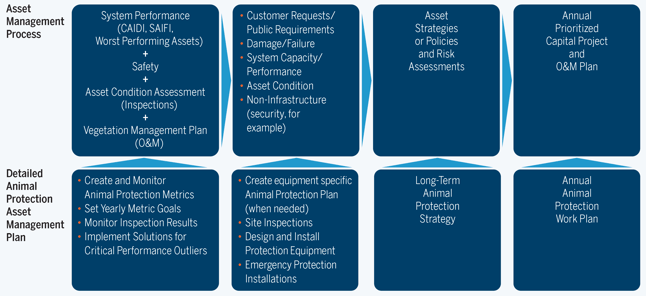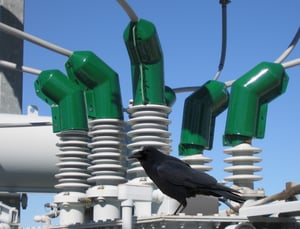What should utilities do in a situation where they are having an animal-caused outage issue and do not know where to start when they are planning to install a new substation?
An animal-caused outage mitigation mindset must exist within all levels of a utility’s asset management process in order to completely manage the issue (see Figure 5). Utilities need to look internally to all of their processes to understand where there are examples of practices that work well and should be reinforced and also recognize areas of opportunity. Detailed in this section is a high-level review of the areas that should be reviewed, analyzed, understood, improved upon or implemented, when necessary, to support the drive toward zero animal-caused outages.

Asset Management Process with the Animal Protection Component Included Figure 5
You Get What You Measure: The Industry View

In order to understand the animal-intrusion issue, including the cause of the issue, utilities need to measure, establish targeted goals and then make informed decisions to meet or exceed those goals.
Utilities must begin by reviewing their management processes for collecting data relating to animal-intrusion caused outages and equipment damage. Utilities need to be more rigorous when it comes to collecting outage data. A lack of data or even inaccurate data can lead to inaction or inappropriate action being applied to a problem. There are a number of reasons why utilities may have difficulty obtaining data; however, performing a review of the data collection methods and driving improvements to the areas of weakness will address this threshold issue. Listed below are some of the top reasons why data has been incomplete or inaccurate and should be used to eliminate reasons why poor data collection processes exist:
- A low-risk outage (momentary outage, limited customers affected, occurrence at night, etc.)
- Data collection did not occur (operator/field personnel were busy, etc.)
- Inconsistent or nonexistent reporting standards (operational drift)
Root-cause analysis, a necessary next step
While time consuming, performing root-cause analysis on a regular basis promotes the discipline necessary to completely understand the cause of any animal-contact issue. The analysis also will rapidly expose common themes, allowing for an informed decision on next steps and an optimized investment in equipment protection. Applying the same practices utilities commonly use for their existing safety-based root-cause analysis is an excellent start to ensuring that this methodology is applied correctly and swiftly.





